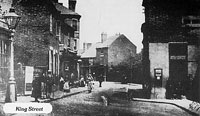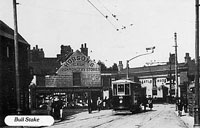Darlaston in history

The early history of Darlaston is shrouded in mystery. The place name, originally 'Deorlaveston', means Deorlaf's settlement. Darlaston is not mentioned in Domesday Book (1086) possibly due to a clerical error.
The South Staffordshire Darlaston seems to have developed after the Norman Conquest. Throughout the Middle Ages it was a small, primarily agricultural settlement. There has been a church on the site now occupied by St. Lawrence's (built 1872) since the 12th century when William de Darlaston, first lord of the Manor of Darlaston, is believed to have founded the first church. William's Manor House is thought to have been situated near to the modern day Campbell Place, just off St. Lawrence Way.
The main streets of the modern town were also medieval thoroughfares - King Street was, and is, the principal shopping street, but it also contained attractive houses where some of Darlaston's wealthier citizens lived. Many street names are reminders of the centuries when Darlaston was a rural village. The Green is, of course, the location of the old village green and Pinfold Street was the site of the pound where stray animals were kept until their owners collected them and paid a fine. Nearby is the Leys, once a field where animals were grazed.
During the 18th and 19th centuries the little agricultural village developed rapidly, as mining and metal trades attracted newcomers to the area. The old common fields and surrounding open land were soon covered in mine shafts and many foundries and workshops sprang up. The town's specialist industries were the manufacture of gun locks (the firing mechanism) and nuts and bolts. A commercial directory of 1851 lists 35 bolt makers working in Darlaston, including a small works established in 1802. In 1870 this firm was inherited by F. W. Cotterill, who built the nucleus of the Atlas Works. In 1919 the works were acquired by Guest, Keen & Nettlefolds Ltd. Over the years GKN absorbed many other nut and bolt works and became a major international company, sadly no longer having any connection with Darlaston.

As industry developed in the town, workers flooded in seeking employment. In 1801 the population of Darlaston stood at 3,812. By 1901 this number had rocketed to 15,395, but provision of adequate housing, sanitation and public amenities for the residents did not keep pace with demand. Consequently the death rate in 19th century Darlaston was unacceptably high and one newspaper described it as 'by far the unhealthiest town in the Black Country'. Gradually things improved, although the clearance of some of Darlaston's terrible slums did not take place until well into the 20th century.
The Urban District Council built a great deal of housing both between the wars and after 1945. The first half of the 20th century also saw the establishment of many new industries in the town, as coal mining declined. In the 50's and 60's the future looked bright for Darlaston but in recent years the decline of its traditional heavy industries has hit Darlaston hard.
Walsall Local History Centre